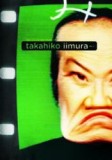| Reviews & Columns |
|
Reviews DVD TV on DVD Blu-ray 4K UHD International DVDs In Theaters Reviews by Studio Video Games Features Collector Series DVDs Easter Egg Database Interviews DVD Talk Radio Feature Articles Columns Anime Talk DVD Savant Horror DVDs The M.O.D. Squad Art House HD Talk Silent DVD
|
DVD Talk Forum |
|
|
| Resources |
|
DVD Price Search Customer Service #'s RCE Info Links |
|
Columns
|
|
|
Collected Films of Takahiko Iimura, The
Microcinema // Unrated // September 30, 2008
List Price: $29.99 [Buy now and save at Amazon]
Call me uncultured, call me lacking in artistic competence, call me whatever you like ... but Takahiko Iimura's work covers a spectrum of experimental cinema I just can't fully grasp. He's an artist, a manipulator of normalcy, who plays with the boundaries of coherent perseverance. Gathered together in this collection are several of his short works, ranging from 6 to 11 minutes, as well as a few of his lengthier pieces that go on for nearly half an hour. Within each, he tries to find a creative rhythm that could relay symbolic and filmic ideals to his audience, but ultimately they just left me in a curious, aggravated stupor. Yet, it's still easy to respect where his branching thoughts and thematic perceptions can go.
The Films:
Takahiko Iimura is a purveyor of perpetual motion, meaning that he gets his audience so wrapped up in the chaos bustling about in his films that they might house a cathartic experience. His work mostly embodies the same kind of properties to that of a giant slab of granite in ancient Roman times. To a sculptor, a giant chunk of beautifully marbleized rock could be the start of a work of art; to Iimura, the rock's untouched and raw properties -- displayed in their uncut form -- would probably seem more beautiful. With that in mind, he relishes in filming with little to no obvious output. There's intricacy at work in his symbolism, but it's interpretive instead of guided symbolism. He just shows you the rock and its contours, leaving it up to you to make heads or tails of it all. It's certainly an welcome and bizarrely engaging experience to watch Takahiko Iimura's films, but one that's more likely to affect the viewer with a stronger potency following a few days of digestion.
Films Listed in Chronological Order:
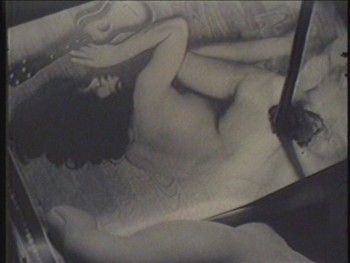 Onan (1963, 7 minutes):
Onan (1963, 7 minutes):
This short holds the only real "narrative" in the collection, as it captures a man engulfed by his perversion and sexual tension. Shortly after searing holes in nude photographs of women with a phallic-shaped rod and -- afterwards -- self-gratifying himself, or so that would seem how Iimura's photography would like for us to perceive it, he discovers an egg "birthed" in between him legs. When confronted with the idea that this may have been his creation, this once-impassioned man now starts to discover maternal tendencies shortly after his orgasm. By far the most compelling work in the collection, Onan tinkers with gradual, real masculine emotionality and eroticism as the focal character playfully and curiously plays with the egg, rendering an odd image of a once perverse man now nurturing the ideals of his passion's product. It can be seen as a metaphor for the cyclical existence of masculine energy, or even as misinterpretation of gender norms once the only other "character" in the film comes out. There's a lot of thought and energy in this seven-minute piece, one that packs more themes than most films ten times its length.
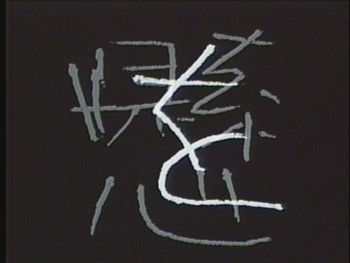 White Calligraphy (1967, 11min):
White Calligraphy (1967, 11min):
Just that -- white Japanese characters slapped together so that they overlap repeatedly in a blitzed fashion. It follows along with Iimura's trance-like cathartic attempts, asking you not to necessarily see the characters but to see the white lines as random artwork. Seeing as how this was made in the late '70s, a time before readily-available word processors, each of these countless upon countless Japanese characters had to be drawn out by hand and pieced together. Similar to the experience behind watching clouds form shapes in the sky, it asks you to relax your eyes and try to piece together images from the randomness of collected, overlapped symbols. This can be intriguing and interesting -- for the first three, maybe even four minutes. Sitting at over eleven minutes, it turns into headache-inducing repetition that could probably send someone into epileptic shock if they focus long enough.
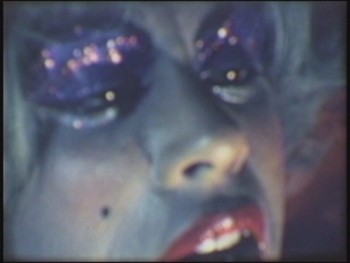 Face (1969, 19min):
Face (1969, 19min):
Probably the most visually intriguing of the series, Iimura's Face also might be the most difficult to embrace. It gyrates and gravitates around "at least" two feminine facial structures, navigating close-ups onto their eyes, lips, and porous skin. One displays a heavy cabaret style of make-up, expressed by Mario Montez of Andy Warhol recognition, while the other harnesses less make-up and more natural beauty, played by Donna Kerness. It creates a questionable dynamic between false, consumer-created beauty and natural, lightly untouched attractiveness, while also addressing the fallacies of what can appear on-screen. It edits between shots of the two talents, showing how seamless edits can interlock two very different entities. What makes it difficult is the runtime, nearly twenty-minutes, and the repetition of cackling laugher that seems to almost mock the audience's perception of the photography.
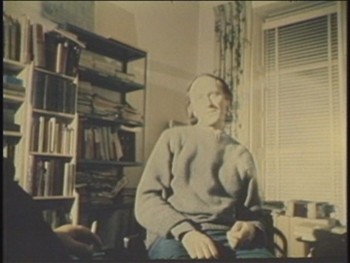 Filmmakers (1969, 28min):
Filmmakers (1969, 28min):
The disc closes with its longest production, a nearly thirty-minute collage of Iimura's trips to meet several influential experimental filmmakers of the '60s. It captures abstract footage of Stan Brakhage, Stan Vanderbeek, Jack Smith, Jonas Mekas, Andy Warhol, and himself, edited together in a barrage of found rudiments. It clearly takes a personal insight into the life of each artist, finding individual items from the collection of footage and bluntly stating their names "window, friends, Stan Vanderbeek", etc. It's VERY drawn out and obviously personal in nature, something that seems like it might create a similar kind of effect to that of watching home videos at a person's house that you don't really know. For this one, there's little perception I can really relate to any kind of symbology, except that experimental artists vary greatly in their styles of lives. It's worth noting that the Warhol footage is very obscured, showing very little of his actual persona.
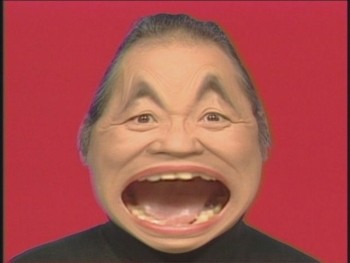 AIUEONN (1993, 6min):
AIUEONN (1993, 6min):
Yikes. Here's where Iimura loses me. The Japanese vowel system differs from the English, in that it doesn't correlate to the "a,e,i,o,u" form. Instead, when mouthing the order of Japanese phoenetic vowels, it's more like "ahh, eee, ooo, eeh, ooh" with a "nnnm" tacked on at the end. At first, AIUEONN shows up with digitally manipulated renders of Iimura's face as he coyly makes the face associates with each of the Japanese vowels. Layered atop this, he attaches post-recorded vowel sounds to mirror his facial features. It gets trickier: later down the string, he starts to mush together Japanese and English vowels, yet keeps the rhythm of Japanese vowels voiced atop. It becomes a form of interactive game, kind of like rubbing your tummy and patting your head in different rhythms while keeping the belly rub in normal motion. Sure, it glues together languages for cultural significance, but it also pushes the boundaries of repetitive nonsense as well once it reaches higher numbers of replication.
The DVD:
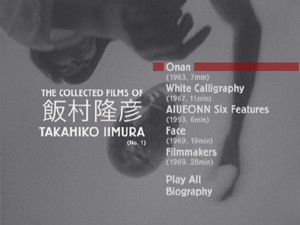
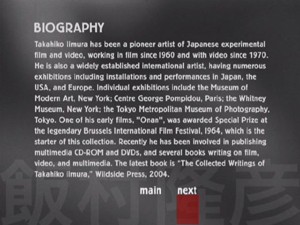
Microcinema has brought us the films of Takahiko Iimura in a standard keepcase presentation with some rather neat artwork that reflects the AIUEONN short film.
The Video:
Well, there's not really a lot to say about this 1.33:1 fullscreen presentation of Iimura's films. Every single one, except the one from the early '90s, comes absolutely littered with hair, dust, scratches, damage ... the works. Several of them have significant damage along the edges, even some banding here and there. Seeing as how the calligraphy is little more than a black background with white lettering, there's nothing noticeably wrong there. Also, AIUEONN seems practically free of any real damamge and, aside from some edge halos, looks pretty solid. It's nice to just have these films in a watchable fashion in a single collection.
The Audio:
Much like the video, the Dolby 2.0 track has a multitude of problems in the older works. Popping and buzzing occur throughout, which mildly distracts from the viewing experience. For a couple of the films that hinge on coping with audio presentations, it's a little difficult to stick with them in this state -- but doable. AIUEONN, of course, sonuds fine, though it's mixed a little loud.
The Extras:
Also included on this disc is a Biography of Takahiko Iimura, as well as a DVDography inside the Biography.
-----
Final Thoughts:
Experimental films doesn't get much more "experimental" than with Takahiko Iimura's early work. He challenges his audience to think outside the box, while assaulting them with enough brash visual stimulation to entrance them in a stupor that might either help or hinder the process. Though compelling, each film is likely to be a one-time experience because of their trying and deliberate aesthetic tone. Iimura's work should be seen, without question, but a Rental should suffice for most interested parties. If this is for an experimental film class of a Japanese cinema course, then the digital transfer is certainly watchable enough for educational purposes and recommended on that front.
Thomas Spurlin, Staff Reviewer -- DVDTalk Reviews | Personal Blog/Site
The Films:
Takahiko Iimura is a purveyor of perpetual motion, meaning that he gets his audience so wrapped up in the chaos bustling about in his films that they might house a cathartic experience. His work mostly embodies the same kind of properties to that of a giant slab of granite in ancient Roman times. To a sculptor, a giant chunk of beautifully marbleized rock could be the start of a work of art; to Iimura, the rock's untouched and raw properties -- displayed in their uncut form -- would probably seem more beautiful. With that in mind, he relishes in filming with little to no obvious output. There's intricacy at work in his symbolism, but it's interpretive instead of guided symbolism. He just shows you the rock and its contours, leaving it up to you to make heads or tails of it all. It's certainly an welcome and bizarrely engaging experience to watch Takahiko Iimura's films, but one that's more likely to affect the viewer with a stronger potency following a few days of digestion.
Films Listed in Chronological Order:
 Onan (1963, 7 minutes):
Onan (1963, 7 minutes): This short holds the only real "narrative" in the collection, as it captures a man engulfed by his perversion and sexual tension. Shortly after searing holes in nude photographs of women with a phallic-shaped rod and -- afterwards -- self-gratifying himself, or so that would seem how Iimura's photography would like for us to perceive it, he discovers an egg "birthed" in between him legs. When confronted with the idea that this may have been his creation, this once-impassioned man now starts to discover maternal tendencies shortly after his orgasm. By far the most compelling work in the collection, Onan tinkers with gradual, real masculine emotionality and eroticism as the focal character playfully and curiously plays with the egg, rendering an odd image of a once perverse man now nurturing the ideals of his passion's product. It can be seen as a metaphor for the cyclical existence of masculine energy, or even as misinterpretation of gender norms once the only other "character" in the film comes out. There's a lot of thought and energy in this seven-minute piece, one that packs more themes than most films ten times its length.
 White Calligraphy (1967, 11min):
White Calligraphy (1967, 11min): Just that -- white Japanese characters slapped together so that they overlap repeatedly in a blitzed fashion. It follows along with Iimura's trance-like cathartic attempts, asking you not to necessarily see the characters but to see the white lines as random artwork. Seeing as how this was made in the late '70s, a time before readily-available word processors, each of these countless upon countless Japanese characters had to be drawn out by hand and pieced together. Similar to the experience behind watching clouds form shapes in the sky, it asks you to relax your eyes and try to piece together images from the randomness of collected, overlapped symbols. This can be intriguing and interesting -- for the first three, maybe even four minutes. Sitting at over eleven minutes, it turns into headache-inducing repetition that could probably send someone into epileptic shock if they focus long enough.
 Face (1969, 19min):
Face (1969, 19min): Probably the most visually intriguing of the series, Iimura's Face also might be the most difficult to embrace. It gyrates and gravitates around "at least" two feminine facial structures, navigating close-ups onto their eyes, lips, and porous skin. One displays a heavy cabaret style of make-up, expressed by Mario Montez of Andy Warhol recognition, while the other harnesses less make-up and more natural beauty, played by Donna Kerness. It creates a questionable dynamic between false, consumer-created beauty and natural, lightly untouched attractiveness, while also addressing the fallacies of what can appear on-screen. It edits between shots of the two talents, showing how seamless edits can interlock two very different entities. What makes it difficult is the runtime, nearly twenty-minutes, and the repetition of cackling laugher that seems to almost mock the audience's perception of the photography.
 Filmmakers (1969, 28min):
Filmmakers (1969, 28min): The disc closes with its longest production, a nearly thirty-minute collage of Iimura's trips to meet several influential experimental filmmakers of the '60s. It captures abstract footage of Stan Brakhage, Stan Vanderbeek, Jack Smith, Jonas Mekas, Andy Warhol, and himself, edited together in a barrage of found rudiments. It clearly takes a personal insight into the life of each artist, finding individual items from the collection of footage and bluntly stating their names "window, friends, Stan Vanderbeek", etc. It's VERY drawn out and obviously personal in nature, something that seems like it might create a similar kind of effect to that of watching home videos at a person's house that you don't really know. For this one, there's little perception I can really relate to any kind of symbology, except that experimental artists vary greatly in their styles of lives. It's worth noting that the Warhol footage is very obscured, showing very little of his actual persona.
 AIUEONN (1993, 6min):
AIUEONN (1993, 6min): Yikes. Here's where Iimura loses me. The Japanese vowel system differs from the English, in that it doesn't correlate to the "a,e,i,o,u" form. Instead, when mouthing the order of Japanese phoenetic vowels, it's more like "ahh, eee, ooo, eeh, ooh" with a "nnnm" tacked on at the end. At first, AIUEONN shows up with digitally manipulated renders of Iimura's face as he coyly makes the face associates with each of the Japanese vowels. Layered atop this, he attaches post-recorded vowel sounds to mirror his facial features. It gets trickier: later down the string, he starts to mush together Japanese and English vowels, yet keeps the rhythm of Japanese vowels voiced atop. It becomes a form of interactive game, kind of like rubbing your tummy and patting your head in different rhythms while keeping the belly rub in normal motion. Sure, it glues together languages for cultural significance, but it also pushes the boundaries of repetitive nonsense as well once it reaches higher numbers of replication.
The DVD:


Microcinema has brought us the films of Takahiko Iimura in a standard keepcase presentation with some rather neat artwork that reflects the AIUEONN short film.
The Video:
Well, there's not really a lot to say about this 1.33:1 fullscreen presentation of Iimura's films. Every single one, except the one from the early '90s, comes absolutely littered with hair, dust, scratches, damage ... the works. Several of them have significant damage along the edges, even some banding here and there. Seeing as how the calligraphy is little more than a black background with white lettering, there's nothing noticeably wrong there. Also, AIUEONN seems practically free of any real damamge and, aside from some edge halos, looks pretty solid. It's nice to just have these films in a watchable fashion in a single collection.
The Audio:
Much like the video, the Dolby 2.0 track has a multitude of problems in the older works. Popping and buzzing occur throughout, which mildly distracts from the viewing experience. For a couple of the films that hinge on coping with audio presentations, it's a little difficult to stick with them in this state -- but doable. AIUEONN, of course, sonuds fine, though it's mixed a little loud.
The Extras:
Also included on this disc is a Biography of Takahiko Iimura, as well as a DVDography inside the Biography.
-----
Final Thoughts:
Experimental films doesn't get much more "experimental" than with Takahiko Iimura's early work. He challenges his audience to think outside the box, while assaulting them with enough brash visual stimulation to entrance them in a stupor that might either help or hinder the process. Though compelling, each film is likely to be a one-time experience because of their trying and deliberate aesthetic tone. Iimura's work should be seen, without question, but a Rental should suffice for most interested parties. If this is for an experimental film class of a Japanese cinema course, then the digital transfer is certainly watchable enough for educational purposes and recommended on that front.
|
| Popular Reviews |
| Sponsored Links |
|
|
| Sponsored Links |
|
|
| Release List | Reviews | Shop | Newsletter | Forum | DVD Giveaways | Blu-Ray | Advertise |
|
Copyright 2024 DVDTalk.com All Rights Reserved. Legal Info, Privacy Policy, Terms of Use,
Manage Preferences,
Your Privacy Choices | |||||||









